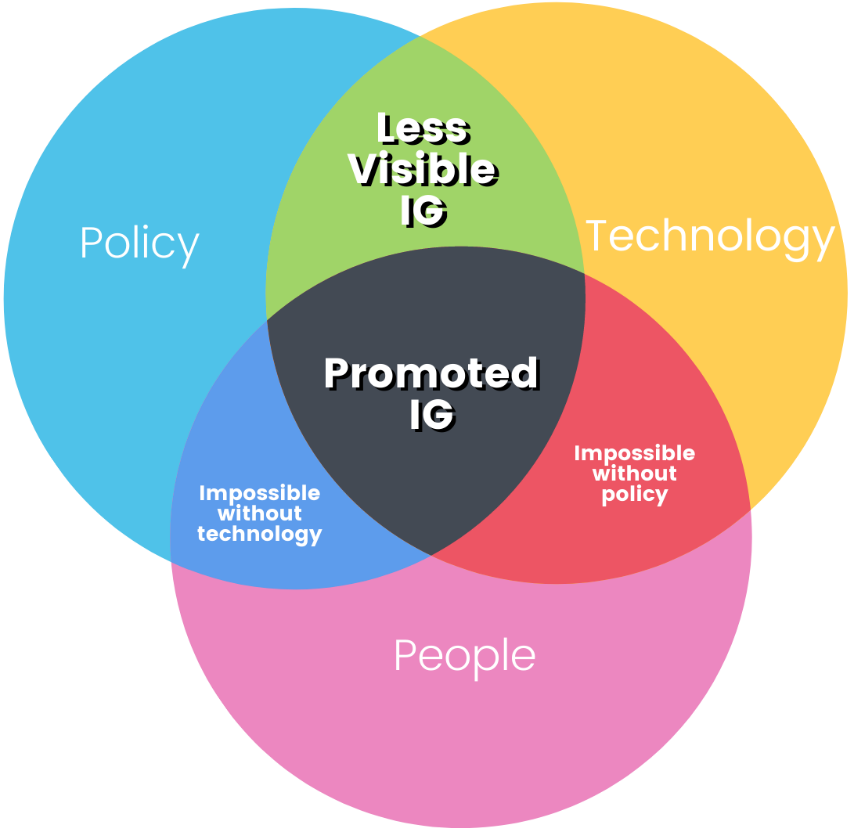
By Nick Inglis
There have been two camps of thought around how to approach Information Governance within an organization.
One view is that Information Governance should be visible and promoted across an organization to build consensus. The other view is that Information Governance should be a behind-the-scenes practice, with few even aware of the program.
In this blog post I’ll address the differences between the two competing approaches to understand which method is best (or, accurately, which method is best for your organization).
Information Governance, Promoted
The more common approach in early Information Governance programs was the promoted IG program.
Usually, the IG team (often the same people running Records and Information Management programs previously) would run the program much like a Records Management program – training employees on appropriate metadata and filing, helping them understand the benefits of Information Governance through teaching and training.
This approach has components that don’t exist in the less visible approach – namely the people aspects – training and marketing/communications.
In the promoted IG approach, training is a way of bolstering practices that may not be self-evident within the information systems – understanding classification, taxonomies, metadata, and how they benefit both the individual and company levels. This approach was necessary for the early Information Governance days because the information systems (or the teams running the information systems – often IT) did not fully understand or in some cases support these kind of policy approaches.
Additionally, a promoted IG approach often had elements of a communications or marketing plan built into it – to help drive new practices across the organization and build consensus among employees. These programs could be as simple as some posters around the office to the complex, such as a regular email list and full marketing support.

The hallmark of the promoted IG approach is that it uses all three methods of pushing the program out to the rest of the organization: policy and technology, yes, and people.
Many successful IG programs utilize the promoted IG approach at companies of all sizes. That isn’t to say that the approach hasn’t had some high-profile failures – most centered around change management issues. In a promoted IG approach, you must build organizational consensus – when that fails, the whole thing fails (or, in the least, stalls). In a promoted IG approach, you have to articulate the benefits to employees to gain their buy-in (especially when processes don’t have forced alignment in information systems and are relying on employees complying with policy). In addition, there are a handful of companies I’m aware of that started with the promoted technique that then moved to a less visible IG approach.
Less Visible Information Governance
The alternative approach to the promoted IG approach is the less visible approach. I’m calling the approach to keep Information Governance hidden behind-the-scenes, the “less-visible IG” approach. The less visible approach is not invisible, IG is still there, but it isn’t as visible as its counterpart.
In this approach, we view IG as more of an administrative task, and we disseminate policy in this approach through both shared written policy and technology. However, unlike the promoted IG approach, no attempts are made to push IG out to the company through the people (either from a training or marketing/communications perspective).
In this approach, you must leave no room for people to attempt to avoid adhering to policy. This is particularly important (and often challenging) when it comes to classifying information. Classification of information within the less-visible IG approach must leave zero room for ways to label data as “other” or “miscellaneous,” two lazy (but common) classification overrides.
Since there is no push for training or marketing/communications in the less visible approach, it is often faster to create than the promoted approach. There is little opportunity for employee pushback against a program with little visibility as most employees won’t have any insight into the program, but rather see the effects of IG in the information systems they use – not as an IG program, but as classification options and policy implementation.
The less visible approach does have one drawback -there is little grassroots support. Often the less-visible programs have narrower support – so executive sponsorship must be acquired (and acquired firmly) early on in the development of the program as there won’t be much opportunity to build support later.
On the other hand, there is a potential benefit of the less visible IG program hidden within that statement. Since the program is less visible, there is also little chance for outward employee rejection or revolt around the IG program that is less visible.
While the less-visible approach has fewer success stories right now, it also has fewer failures (fewer companies have taken this approach thus far). There have also been some high-profile success stories with the less visible approach.
A less-visible approach is also an approach that can be successful. It may be more successful as we see these programs develop over time (there isn’t data available for wide-scale data-based evaluation of approaches yet).
Which approach is better?
Not to sound like a consultant, but… it depends.
The promoted approach can work well when you have a strong team culture in your organization. Where I’ve seen challenges to the promoted approach (besides issues created by new policy decisions) has been where employee culture is either very individual-focused or merely a weak culture.
If there is the chance for people problems when an organization implements Information Governance, a less visible approach is likely to be a more successful model.
There is no better or worse; you’ll need to pick the approach that works best for your organization.
Choose the best approach for you
At IPRO, we support programs operating under either approach – the promoted or the less visible. Our IG tools run behind the scenes as a single view into information that resides across multiple information systems, ensuring consistency no matter which approaches you select.
You can utilize IPRO tools no matter your approach, and that isn’t always the case; we’re proud to be an ideal choice to support any Information Governance effort.



